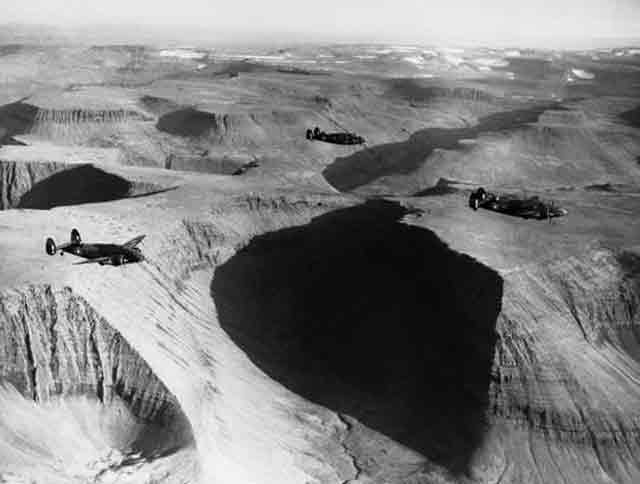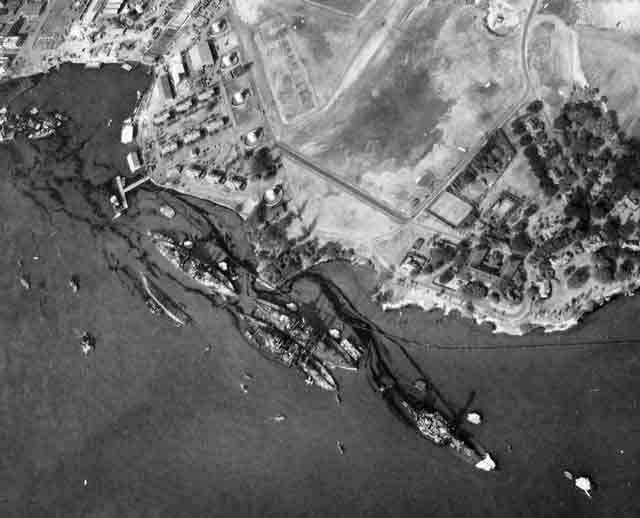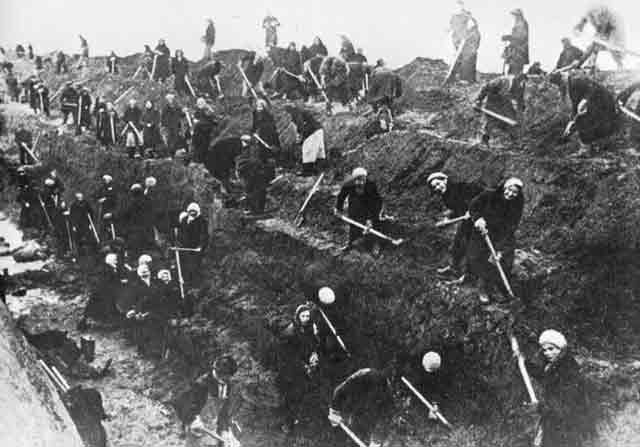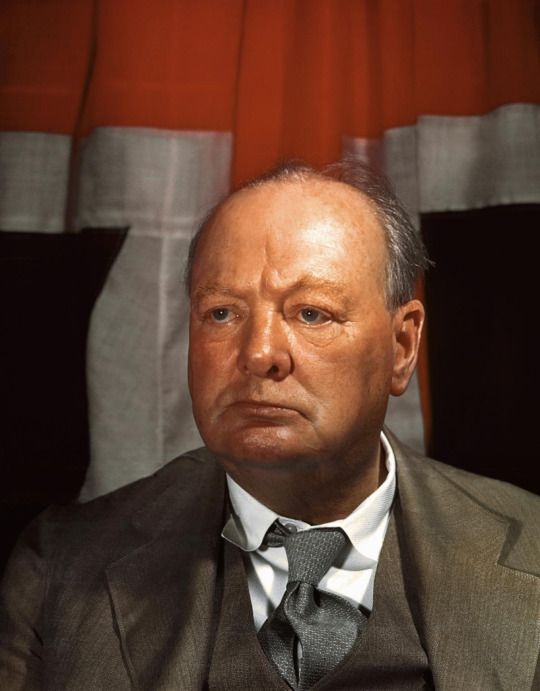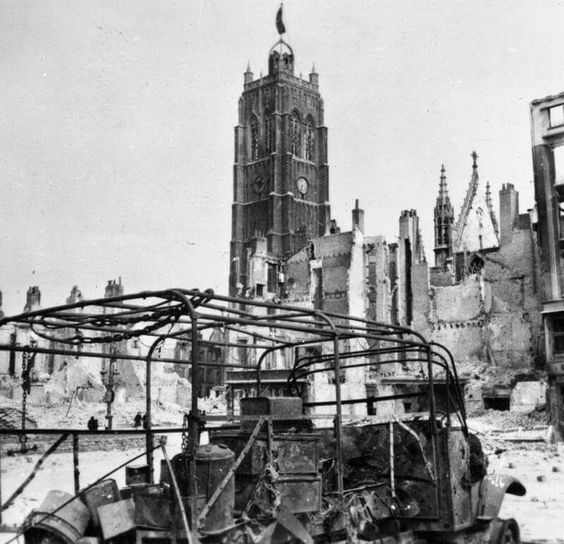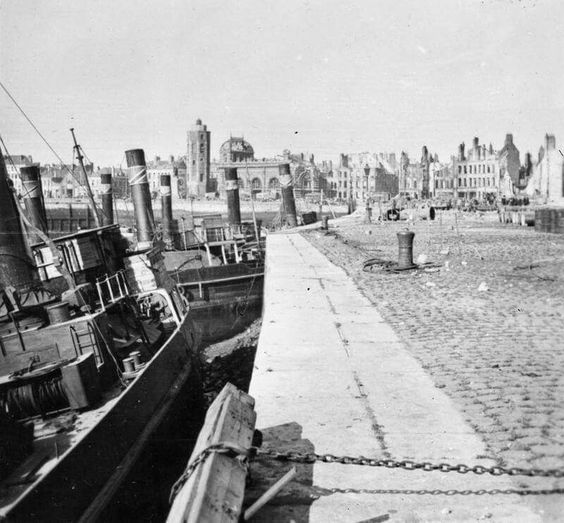Italian/Greek Campaign: The Greek offensive in Albania grinds forward on
28 November 1940, the men braving blizzards and rocky terrain to push the Italians back. There are few villages to mark their progress, but they are making good ground that is gradually bringing them closer to important Italian bases.
Greek II Corps is reinforced again, this time with the Cavalry Division. The Corps now has received two fresh divisions in two days. The Cavalry Division crosses the Legatitsa River and continues the advance toward Përmet (Premeti).
Greek III continues moving toward Pogradec, the most significant objective off its front.
Greek troops occupy the heights above Argyrokastro (Gjirokastër), a historic town in Epirus. However, the Italians still hold the town and are fighting hard to keep it.
Italian destroyers Pigafetta, Da Recco, Pessagno, and Riboty, accompanied by torpedo boats Prestinari and Bassini, bombard Greek positions on Corfu. The Italian high command has given up early plans to invade the island. The RAF raids the ports of Porta Santi Quaranta in southern Albania, Durazzo, Brindisi and Elbasan in central Albania.
European Air Operations: RAF Bomber Command sends bombers against Mannheim, Dusseldorf, the synthetic oil installation at Politz, Stettin, Cuxhaven, Antwerp, Boulogne, and Le Havre.
The Luftwaffe sends over 40 fighter-bombers (Jabos) during the day, but they accomplish little. Daylight raids are increasingly pointless, particularly with the shortening hours of daylight, but the Luftwaffe continues with occasional Jabo sweeps. Losses are about even, with half a dozen planes lost by each side.
The Luftwaffe, recently having pounded several other moderate-sized English cities such as Coventry and Brighton with large-scale raids, turns its attention to Liverpool during the night. It sends 340 bombers which drop massive parachute land mines. The raid kills 164-166 and injures 96 more when a landmine scores a direct hit on a shelter at Edge Hill Training College on Durning Road. The scene is gruesome, as it is not the blast that kills everyone, but rather boiling water released from a boiler and gas from damaged pipes.
 |
| John Charles Dundas, who perished on 28 November 1940 after shooting down Luftwaffe ace Helmut Wick. Dundas had 12 victories. |
Helmut Wick, one of the Luftwaffe's leading aces, has a good day that turns horribly wrong. He gets a victory in the morning, his 55th, and then during the afternoon scores his 56th confirmed kill. This finally catches fellow Luftwaffe ace Adolf Galland, who Wick has been chasing since the war began.
However, shortly after, Wick meets his own fate. It is believed to be at the hands of Flight Lieutenant Dundas (RAF No. 609 Squadron) near the Isle of Wight. Dundas probably never knows who he shot down, however, because minutes later he himself is killed in the same air battle.
Wick is last seen baling out over the Channel and likely landed while still alive in the water. The winter weather is unforgiving, the sea is cold, and the rescue can't happen enough. In fact, Wick's body is never found. As happens more than once in the continuing battle, the downed airman's Luftwaffe colleagues circle above the downed pilot as long as they can. One, Hptm. Rudi Pflanz stays so long that he has to crash land in France because he runs out of fuel. One of the crueler aspects of the Battle of Britain - and war in general, on both sides - is that so many men must watch their friends and colleagues die moments after they were alive, well and at the top of their game.
Wick is a propaganda hero, and in one of those freaky coincidences is on the cover of that day's German propaganda publication, Berliner Illustrirte Zeitung (BIZ). He is standing beside
Hermann Goering, whose wayward decisions have sabotaged the Luftwaffe effort and helped keep the RAF strong.
The new Kommodore of JG 2, replacing Wick, is Hptm. Karl-Heinz Greisert.
Lt Harold Reginald Newgass earns the George Cross for disarming a land mine lodged in a fuel tank full of coal gas.
 |
| The cover of BIZ No. 48, 28 November 1940. That is Helmut Wick on the right (I believe). |
Battle of the Atlantic: The weather is very rough in the mid-Atlantic. This makes the merchant marine service increasingly all-or-nothing around this time, because either you make it across or have a ship close at hand to rescue you if you get torpedoed - or you don't. And, if you don't, your odds of survival are not good. The action is erratic, with equipment not always acting the way it would in more normal weather and more unsuccessful attacks than usual.
U-104 (Kptlt. Harald Jürst) and its 49 crewmen, after having torpedoed two ships on the 27th (and sinking one), disappears into the sea, with nobody surviving. The most common theory is that the U-boat wandered into a defensive Royal Navy minefield (SN 44, laid on 8 November) northwest of Londonderry, County Derry, Northern Ireland. It is not known when it sinks, either, as it is not considered missing by the Kriegsmarine until well into December.
U-103 (Kplt. Viktor Schütze), on its second patrol out of Lorient, is operating in the Atlantic sea lanes about 930 km from Bishop Rock (200 miles southwest of Rockall). It downs two ships. First, it torpedoes 3578 ton Greek freighter Mount Athos. There are 19 deaths. Mount Athos is a straggler from Convoy OB 248 and sinks within four minutes. However, even in that short time, the wireless operator manages to get out a message with the ship's position. Nine survivors are picked up on the 30th by an escort from Convoy OB 251, HMS Vanquisher.
U-103 also torpedoes and sinks 4940-ton British freighter St. Elwyn. There are 16 survivors and 24 men perish. Survivors are picked up by British freighter Leeds City.
U-95 (Kptlt. Gerd Schreiber), on its first patrol out of Kiel, fires two torpedoes at 1298-ton Norwegian collier Ringhorn and misses with both. It is possible that the torpedoes are defective - there are problems with torpedoes in the cold during the war's early years. In any event, Schreiber, undoubtedly frustrated at wasting so much ordnance on a relatively small ship, surfaces and uses his deck gun. The Germans damage the freighter and the crew abandons ship, expecting it to sink. However, they later reboard it and bring it to port at Belfast.
Greek 2950-ton freighter Eugenia Cambanis, traveling in convoy SC 13 in the Atlantic off Newfoundland, sinks in a gale after its cargo shifts. Sources are unclear on what happens to the crew, either they all live or all perish - the story of the Battle of the Atlantic. The crew abandons the ship, certain it will capsize and sink... but it doesn't sink. The derelict, in fact, does not go to the bottom until finally shelled by Norwegian patrol boat Hilda Knudsen on 19 December.
Royal Navy 221-ton trawler HMT Manx Prince hits a mine and sinks off the mouth of the Humber in the North Sea, about 5 km from Spurn Point, Yorkshire. Everybody aboard survives, taken aboard minesweeping trawler HMS Cortina.
The German coastal guns at Cap Gris Nez (Hellfire Corner) score a rare long-range success - sort of - when they hit 1167 ton British freighter Skipjack at Dover. However the ship is only damaged, and at that distance, there is little chance of a successful follow-through. The Skipjack makes it to port for repairs.
Italian submarine Dessie fires torpedoes at light cruiser HMS Glasgow in the Atlantic and misses.
Convoy OB 251 departs from Liverpool, Convoys Sl 575 and SL 57 depart from Freetown.
Australian destroyer HMAS Napier (G 97, Captain Stephen H. T. Arliss) is commissioned.
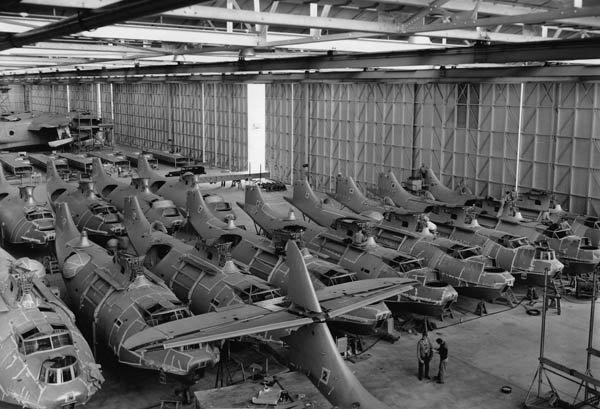 |
| Consolidated Model 28 - U.S. Navy PBY - flying boats in final assembly at the Consolidated Aircraft factory in San Diego in November 1940. Photo credit: Consolidated Aircraft. |
Battle of the Mediterranean: British submarine HMS Regulus goes missing in the Aegean. It is presumed lost due to a mine. Nobody survives.
Operation Collar continues, with battleship HMS Malaya covering the return of Convoy ME 4 - the outward-bound voyage of the Malta convoy MW 4 - to Alexandria.
Operation Canned commences off Italian Somaliland. Light cruiser HMS Leander departs from Aden in a mission to bombard Italian positions at Banda Alulu.
At Malta, there are several air raids as ships arrive at 14:30 in Grand Harbour from the Operation Collar convoys. The Italians are active because they know that there are many British ships operating in the area due to Operation Collar. A raid by half a dozen CR 42 fighters, followed by ten bombers escorted by another ten fighters, around 13:30 is particularly fierce. The Italians lose an SM 79 bomber and a fighter. The British freighters, meanwhile, sustain no damage and unload quickly.
 |
| Henry Maitland Wilson, Italy, 30 April 1944 (Imperial war Museum TR 1762). |
North Africa: British Middle East Commander Archibald Wavell is busy planning Operation Compass, the planned offensive against the Italians in Egypt. He orders the Commander of British Troops Egypt, Lieutenant General Sir Henry Maitland Wilson, to prepare limited five-day operations. He writes to Wilson:
I do not entertain extravagant hopes of this operation but I do wish to make certain that if a big opportunity occurs we are prepared morally, mentally and administratively to use it to the fullest.
The general plan of attack will be to send British and Indian troops through the Sofafi–Nibeiwa gap, with armored formations attacking Nibeiwa from the west.
German/Yugoslavian Relations: Yugoslavian Foreign Minister Aleksandar Cincar-Markovic meets with Hitler in Berlin. Hitler pressures Yugoslavia to sign the Tripartite Pact, but the Serb-dominated officer corps violently opposes this. Regent Prince Paul of Yugoslavia knows that signing the agreement will only cause trouble and is extremely leery, so the Yugoslavs pass. Hitler proposes a bizarre swap, a Yugoslavian alliance in exchange for the Greek seaport of Salonika - which the Greeks still possess. At this point in time, Hitler is offering potential allies territory which he has no ability to give, and the offers themselves illustrate his intentions.
Soviet Military: Konstantin Rokossovsky, a former prisoner accused of treason (on fabricated evidence) but released from Kresty Prison in Leningrad for unexplained reasons on 22 March 1940, assumes command of the newly formed 9th Mechanized Corps in the Kyiv Military District. It has the 19th and 20th Tank Divisions and the 131st Motorized Division. Soviet records can be obscure, but it appears Rokossovsky takes over from the start. Rokossovsky only survived the 1930s officer purges because he refused to sign a false statement, but was badly beaten for doing so. He never blamed Stalin for his mistreatment, but rather the NKVD (Soviet secret police).
Romania: Following the Iron Guard's brutal assaults on its political enemies on the 27th, Ion Antonescu's government declares a state of emergency.
China: The commander of the Japanese 11th Army in Hubei Province (Han River sector), Lieutenant General Waichiro Sonobe, orders a retreat under pressure from the continuing Chinese offensive. The Japanese engage in a scorched earth policy, burning down villages and inflicting heavy casualties on civilians and the advancing Chinese troops.
Holocaust: German Reserve Police Battalion 101 is assigned to guard the perimeter of the Lodz ghetto and shoot anyone who tries to leave.
German Homefront: The German film industry remains quite active throughout the war. Today, it releases its most notorious films, "The Eternal Jew" (Der ewige Jude), likely the most anti-Semitic film ever made. Directed by Fritz Hippler and with a screenplay by Eberhard Taubert, it interweaves documentary footage with acting. Many view this film as a response to a 1934 British film of the same name which portrayed Jews in a sympathetic light.
British Homefront: The government increasingly is trying to shape the lives of its citizens to better withstand what now looks to be a long-term siege of Great Britain. Two different authority figures give their views today, and their news is not good. However, it is judicious and necessary from a medical perspective.
Lord Horder, who chairs the British Medical Committee, has grown increasingly concerned about the risk of epidemics due to the devastation being wrought to dwellings and the other signs of aerial combat (such as dead bodies). He cautions the public that "We have more to fear from germs than Germans."
Lord Woolton, the Minister of Food who recently ended banana imports, has further bad news. he announces a cut in milk rations during the winter months. The government further advises that milk may be unsafe without first boiling it to reduce the risk of typhoid.
 |
| Opening Fashion Exhibit at the Parsons School of Design. New York City, 28 November 1940. |
November 1940 November 1, 1940: Hitler IrateNovember 2, 1940: U-31 Sunk - AgainNovember 3, 1940: Kretschmer's Master ClassNovember 4, 1940: Spain Absorbs TangierNovember 5, 1940: Jervis Bay Meets Admiral ScheerNovember 6, 1940: San Demetrio IncidentNovember 7, 1940: Galloping GertieNovember 8, 1940: Italian Shakeup in GreeceNovember 9, 1940: Dutch Fascists MarchNovember 10, 1940: Fala and Doc StrangeNovember 11, 1940: Taranto RaidNovember 12, 1940: Molotov Takes BerlinNovember 13, 1940: Molotov Foils HitlerNovember 14, 1940: Moonlight SonataNovember 15, 1940: Warsaw Ghetto SealedNovember 16, 1940: France Keeps BattleshipsNovember 17, 1940: Malta Hurricane DisasterNovember 18, 1940: Hitler Berates CianoNovember 19, 1940: Birmingham DevastatedNovember 20, 1940: Hungary Joins AxisNovember 21, 1940: Dies White PaperNovember 22, 1940: Italians Take KorçëNovember 23, 1940: U-Boat Bonanza!November 24, 1940: Slovakia Joins InNovember 25, 1940: Molotov's DemandsNovember 26, 1940: Bananas Be GoneNovember 27, 1940: Cape Spartivento BattleNovember 28, 1940: Wick PerishesNovember 29, 1940: Trouble in IndochinaNovember 30, 1940: Lucy and Desi Marry2020




